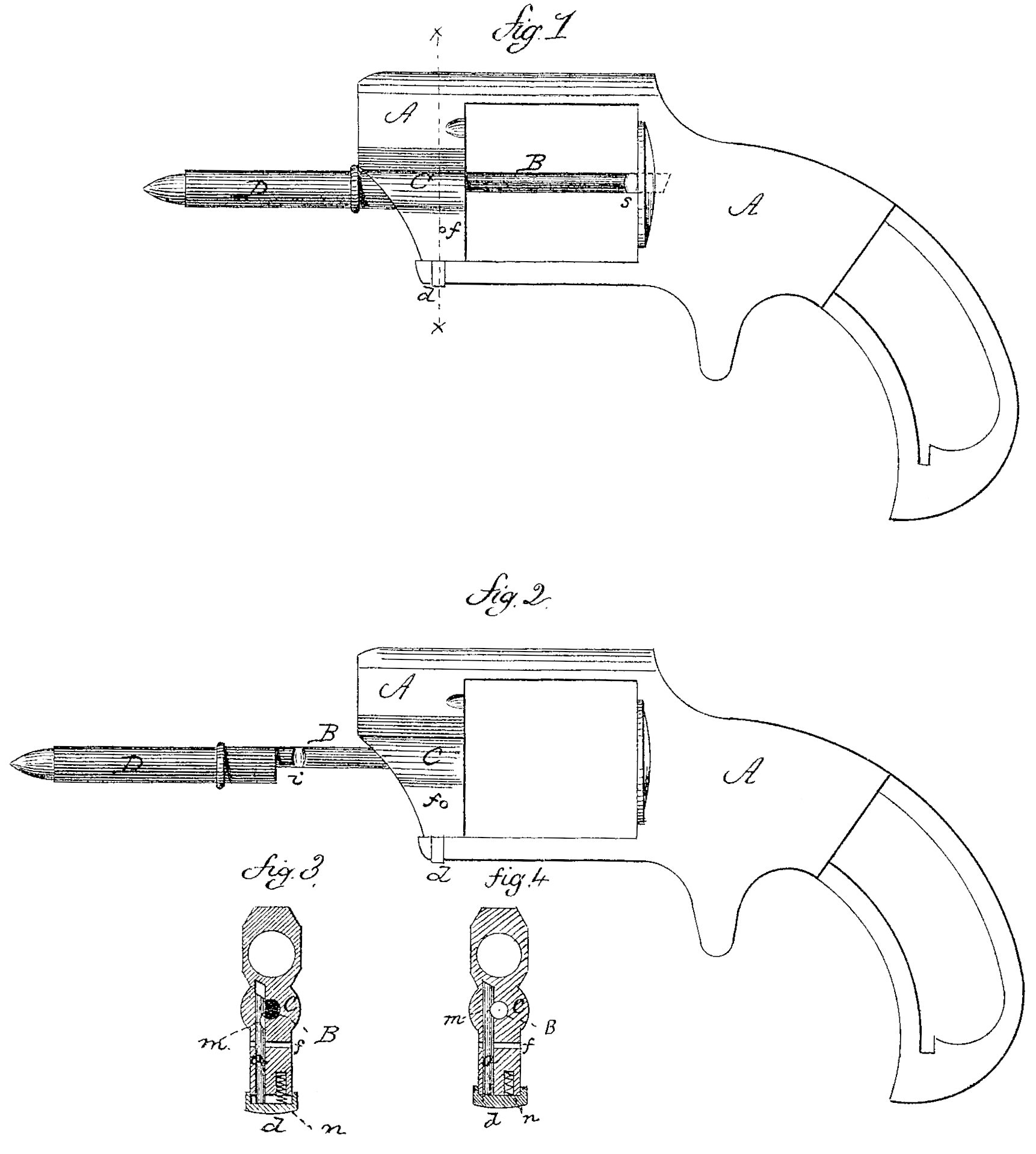US 115258
UNITED STATES PATENT OFFICE.
ELI WHITNEY, OF NEW HAVEN, CONNECTICUT.
IMPROVEMENT IN REVOLVING FIRE-ARMS.
Specification forming part of Letters Patent No. 15,258, dated May 23, 1871.
To all whom it may concern:
Be it known that I, Eli Whitney, of New Haven, in the county of New Haven, and State of Connecticut, have invented a new Improvement in Revolving Fire-Arms; and I do hereby declare the following, when taken in connection with the accompanying drawings and the letters of reference marked thereon, to be a full, clear, and exact description of the same, and which said drawings constitute part of this specification, and represent, in—
Figure 1, a side view of the frame and spindle, the spindle in place as when securing the cylinder; Fig. 2, the same with the spindle withdrawn, as for the removal of the cylinder; Figs. 3 and 4 vertical sections on line x x.
This invention relates to an improvement in revolving fire-arms, the object being a convenient device for removing the cylinder; and it consists in combining with the spindle, which forms the bearing on which the cylinder revolves, a vertical latch, arranged in the frame, which will fall into a notch in the spindle when in its home position, and also into a similar notch when the spindle is withdrawn. sufficiently to permit the removal of the cylinder, thus preventing the entire removal of the spindle and avoiding the liability to lose the said spindle.
A is the frame, of common construction; B, the spindle or bearing, which passes centrally through the cylinder and forms the axis upon which the cylinder turns. It rests in a bearing, t, in the frame, with an end, D, projecting from the frame, which, under certain circumstances, may be used to force the exploded shells or cartridges from the chambers.
In the forward part of the frame I arrange a vertical slide, a, (see Fig. 3,) which extends down to the under side of the frame and is formed into or fixed in a head, d. A pin, f, or similar device, is inserted in the frame, passing through a slot in the said slide to prevent its removal entirely from the frame, and a suitable spring, n, is arranged to force the slide down ward, as in Fig. 3. The said slide is arranged in such relative position to the seat for the spindle B as to enter upon one side of the said seat, and the said slide is at one point, m, grooved, so that when the slide is pressed upward the said groove will conform to that portion of the seat for the spindle through which it passes, as seen in Fig. 4, but when down, as in Fig. 3, that portion of the seat is filled by the said slide.
On the spindle, at a point, i, (see Fig. 2,) a notch is formed in the spindle, this point being in such relative position that when the spindle is fully inserted, as in Fig. 1, the slide a will rest in the said notch. Near the end of the spindle a similar notch, s, is formed, which is in such position that when the spindle is withdrawn, as in Fig. 2, the slide a will rest in the said notch s.
The operation is as follows: Supposing the spindle to be in the position seen in Fig. 1, the slide will be in the position seen in Fig. 3. Holding the spindle in that position, press upon the head D to force the slide into the frame, as in Fig. 4, which brings the notch m into line with the seat of the spindle. Then the spindle may be withdrawn until the notch S comes in line with the slide. Then the slide will fall into the said notch s and prevent its further removal, unless it be desirable to entirely remove the spindle, which may be done by pressing the slide inward, as before. To return the spindle, press the slide in, as before, return the spindle, and when in place the slide will fall into the notch i and again secure it.
If desirable, only one of the notches may be employed, which may be either to prevent the entire removal of the spindle, as in the case of the notch s, or secure it in position only, as the notch i.
I claim as my invention—
In combination with the spindle B, constructed with the notches i or s, one or both, and arranged in the frame, as described, the notched slide a, arranged and operating, as specified, to lock and secure the spindle.
ELI WHITNEY.
Witnesses:
A. J. Tibbits,
J. H. Shumway.

